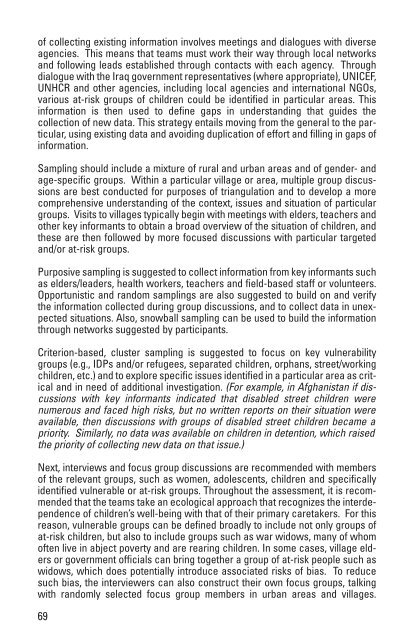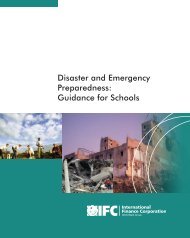Starting Up Child Centered Spaces in Emergencies: A Field Manual
Starting Up Child Centered Spaces in Emergencies: A Field Manual
Starting Up Child Centered Spaces in Emergencies: A Field Manual
- No tags were found...
Create successful ePaper yourself
Turn your PDF publications into a flip-book with our unique Google optimized e-Paper software.
of collect<strong>in</strong>g exist<strong>in</strong>g <strong>in</strong>formation <strong>in</strong>volves meet<strong>in</strong>gs and dialogues with diverseagencies. This means that teams must work their way through local networksand follow<strong>in</strong>g leads established through contacts with each agency. Throughdialogue with the Iraq government representatives (where appropriate), UNICEF,UNHCR and other agencies, <strong>in</strong>clud<strong>in</strong>g local agencies and <strong>in</strong>ternational NGOs,various at-risk groups of children could be identified <strong>in</strong> particular areas. This<strong>in</strong>formation is then used to def<strong>in</strong>e gaps <strong>in</strong> understand<strong>in</strong>g that guides thecollection of new data. This strategy entails mov<strong>in</strong>g from the general to the particular,us<strong>in</strong>g exist<strong>in</strong>g data and avoid<strong>in</strong>g duplication of effort and fill<strong>in</strong>g <strong>in</strong> gaps of<strong>in</strong>formation.Sampl<strong>in</strong>g should <strong>in</strong>clude a mixture of rural and urban areas and of gender- andage-specific groups. With<strong>in</strong> a particular village or area, multiple group discussionsare best conducted for purposes of triangulation and to develop a morecomprehensive understand<strong>in</strong>g of the context, issues and situation of particulargroups. Visits to villages typically beg<strong>in</strong> with meet<strong>in</strong>gs with elders, teachers andother key <strong>in</strong>formants to obta<strong>in</strong> a broad overview of the situation of children, andthese are then followed by more focused discussions with particular targetedand/or at-risk groups.Purposive sampl<strong>in</strong>g is suggested to collect <strong>in</strong>formation from key <strong>in</strong>formants suchas elders/leaders, health workers, teachers and field-based staff or volunteers.Opportunistic and random sampl<strong>in</strong>gs are also suggested to build on and verifythe <strong>in</strong>formation collected dur<strong>in</strong>g group discussions, and to collect data <strong>in</strong> unexpectedsituations. Also, snowball sampl<strong>in</strong>g can be used to build the <strong>in</strong>formationthrough networks suggested by participants.Criterion-based, cluster sampl<strong>in</strong>g is suggested to focus on key vulnerabilitygroups (e.g., IDPs and/or refugees, separated children, orphans, street/work<strong>in</strong>gchildren, etc.) and to explore specific issues identified <strong>in</strong> a particular area as criticaland <strong>in</strong> need of additional <strong>in</strong>vestigation. (For example, <strong>in</strong> Afghanistan if discussionswith key <strong>in</strong>formants <strong>in</strong>dicated that disabled street children werenumerous and faced high risks, but no written reports on their situation wereavailable, then discussions with groups of disabled street children became apriority. Similarly, no data was available on children <strong>in</strong> detention, which raisedthe priority of collect<strong>in</strong>g new data on that issue.)Next, <strong>in</strong>terviews and focus group discussions are recommended with membersof the relevant groups, such as women, adolescents, children and specificallyidentified vulnerable or at-risk groups. Throughout the assessment, it is recommendedthat the teams take an ecological approach that recognizes the <strong>in</strong>terdependenceof children’s well-be<strong>in</strong>g with that of their primary caretakers. For thisreason, vulnerable groups can be def<strong>in</strong>ed broadly to <strong>in</strong>clude not only groups ofat-risk children, but also to <strong>in</strong>clude groups such as war widows, many of whomoften live <strong>in</strong> abject poverty and are rear<strong>in</strong>g children. In some cases, village eldersor government officials can br<strong>in</strong>g together a group of at-risk people such aswidows, which does potentially <strong>in</strong>troduce associated risks of bias. To reducesuch bias, the <strong>in</strong>terviewers can also construct their own focus groups, talk<strong>in</strong>gwith randomly selected focus group members <strong>in</strong> urban areas and villages.69
















